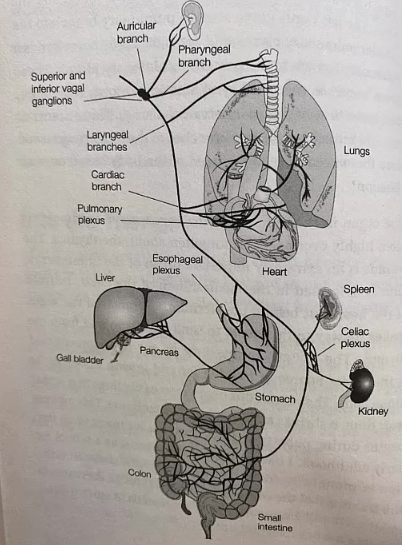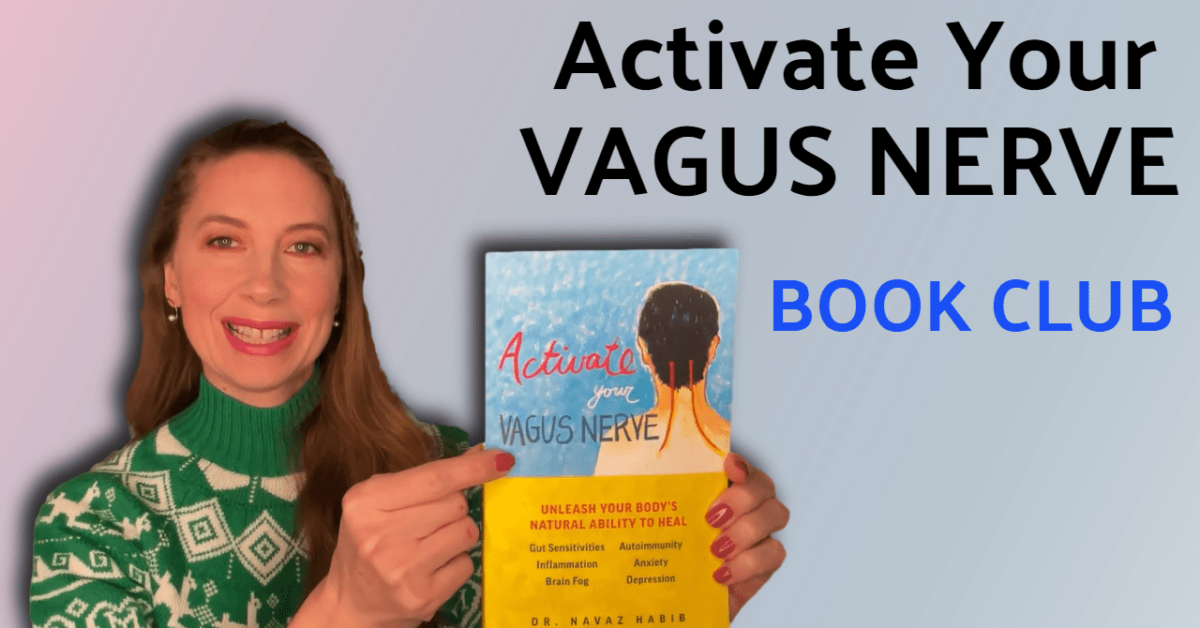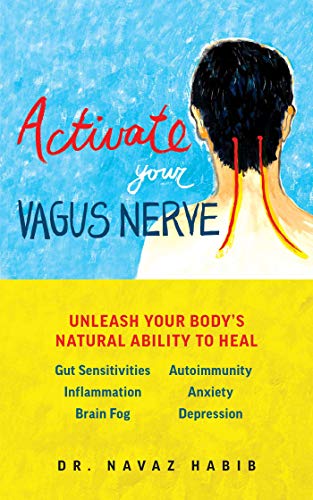Welcome to our book club. You voted on what book for me to read and summarize and this book [Activate Your Vagus Nerve: Unleash Your Body’s Natural Ability to Heal] got so many votes!
In this section, I will go over what the vagus nerve is and discuss the physical observables. If someone has issues with their vagus nerve, we will focus on behaviors like digestion and a variety of the big autism observables.
This is a great book that really explains in a very easy way, the vagus nerve, and then in the second section, what I’m gonna do is talk about how you improve vagus nerve function based upon the book. I’ll go over the exercises that are in this book and they have some really great ones that you can have your child do in therapy.
There are great ideas here to ask your child’s therapist. Okay. How about we try something along this way? Anyone can benefit from these exercises so you could even do it with your child if you want. You don’t have to. But plenty of ideas and exercises, things to do that really strengthen the vagus nerve. You can check out my video below if you are a visual learner.
This is a great book about activating your vagus nerve.
We’re going to learn about what the vagus nerve is and what it controls. And then the second section is all about how you stimulate it.
What is the vagus nerve?
The vagus nerve is the longest nerve in the body. It originates in the brain stem and the brain stem is responsible for the automatic functions of the body aka, the autonomic nervous system.
Functions of the autonomic nervous system include the beating of the heart, breath rate, and depth blinking of eyelids, detoxing, and liver and kidneys, digestion, produce saliva and tears, constriction, dilation of blood vessels, sweat glands, pupil dilation, constriction, urination, and sexual arousal.
How does that work? That’s a lot for one nerve to be involved in.
There are two types of neurons:
Afferent neurons take information from the body to the brain and that’s the majority of the flow of the information. So the body is communicating to the brain, what’s going on and
Efferent neurons take information from the brain to the body. The information flows in two ways. This is a bidirectional highway of information, neurotransmitters are how the brain communicates.
Acetylcholine is a neurotransmitter used most by the vagus nerve and it has a major anti-inflammatory effect on the body.
Where is Vagus Nerve?
Alright, we know the vagus nerve starts in the brain stem but where else is the vagus nerve? It goes into the neck and then into the chest area and then the abdomen. and here’s a picture from the book that shows all the intertwining of the organs that the vagus nerve is involved in.

The vagus nerve is the largest nerve. It is involved in so much in our body and as you hear me explain what the vagus nerve does and what happens when the vagus nerve doesn’t operate optimally, you might start thinking about certain symptoms of your child with autism.
Functions of the vagus nerve
The vagus nerve is the conductor of the body. So think of an orchestra, think of the conductor. The conductor is really having everything move optimally. Everybody’s looking to the conductor as to what to do when the conductor is not operating functionally. There can be quite a bit of a problem, right? And it doesn’t have to be universally the same problem for everybody.
The functions of the vagus nerve:
- sensing the skin of the ear
- allowing food to be swallowed
- managing your airway and vocal cords
- controlling breathing and heart rate
- maintaining optimal blood pressure
- controlling the many functions of the liver
- gall bladder emptying
- managing hunger, and satiety (this is a big one for some people with autism, not for every person with autism, but for some)
- managing blood sugar and insulin levels
- release of digestive enzymes from the pancreas (this is another hot topic for those with autism, digestive enzymes and really having optimal digestion)
- managing gut motor function
- managing the activity of the immune system
- managing inflammation of the gut
- relaying information from the microbiome to the brain and elsewhere in the body
These are a variety of functions of the vagus nerve. The book goes into detail about each of these topics. So if you’re certainly interested in a particular topic, I recommend going buy the book and reading the section on it but this is how important the vagus nerve is.
How does the vagus nerve affect autism in autism?
Many times there is less than optimal functioning of the vagus nerve, which is why some of those functions are health issues for those with autism. Not every single one of those issues is an issue for those with autism. Right, there’s variability here.
The Vegus nerve has many functions. So it’s possible for one person with autism to experience things differently than another person with autism who has different vagus nerve health challenges. If any, you can see this is where the variability comes into autism.
What disorders affect the vagus nerve?
Disorders that have high inflammation, so the vagus nerve is really controlling the whole body, right? But it’s also controlling information. If there’s a high level of information, that’s typically when we start to see disease and that’s when a diagnosis can be made. So what disorders besides autism can affect the vagus nerve are:
- Alzheimer’s disease,
- Arthritis,
- Asthma,
- Cancer,
- Crohn’s disease,
- Diabetes,
- Heart and cardiovascular disease,
- High blood pressure,
- and other conditions that end in the suffix – itis
and so this is part of the book that does the background that talks about what it is, where it’s located, and what functions the vagus nerve overseas, many questions become about how you have the vagus nerve optimally functioning.
Vagus Nerve Stimulation, Autism, Epilepsy
There is something called vagus nerve stimulation and how that’s involved with autism and epilepsy.
This is a quote pulled from a publication directly, not the book. This is a scientific publication:
“Vagus Nerve Stimulation(VNS) is a safe and effective therapy for pediatric patients with drug-resistant epilepsy(DRE). However, in Children with drug-resistant epilepsy, the effects of vagus nerve stimulation on autistic behaviors remain controversial.”
So this is a new area. It’s not extremely well-studied.
And in the next section, I’ll go over different ways that the vagus nerve can be stimulated and activated from a more holistic standpoint.
References:
Activate Your Vagus Nerve: Unleash Your Body’s Natural Ability to Heal
Front Pediatr. 2022 Mar 2;10:846301
Activating your Vagus Nerve
This is the second section of the book club for this book. I broke it into two sections because the vagus nerve is very important. In the first section above, I went over what the vagus nerve is and discussed the physical observables there are if someone has issues with their vagus nerve, we focussed on behaviors, digestion, and the big autism observables.
In this section, I’ll go over how to measure vagus nerve functioning. Yes, measure! That way, when you do exercises, you can actually measure your improvement, that’s really important to do.
This book has some great exercises to strengthen the vagus nerve and it’s all about improving vagus nerve function and quantifying that improvement.
I’ll list them out, so you can ask your child’s therapist to do them or add them to your child’s IEP as goals, anyone can benefit from doing these exercises. So you could even do it with your child if you want to (you don’t have to), you certainly can have these exercises done by somebody else with your child.
Let’s learn about activating your vagus nerve but first, let’s learn about measuring vagus nerve functioning, this is important to do firsthand, right? Because if you want to activate it, you want to know how it functioned before you did different exercises, so it is very important to quantify.
Measuring Vagus Nerve functioning
There are four methods to measure vagus nerve function:
- Heart rate variability
- Heart rate
- Breath pattern
- Bowel transit time
The book goes into detail about all of that. So if you’re interested in the details of how to do that, I certainly recommend the book.
Exercises to activate the Vagus nerve
- Breathing exercises
- Sleeping on your side
- Periodic cold exposure
- Humming or chanting
- Activating the gag reflex
- Gargling
- Yoga
- Meditation
- Sunlight exposure
- Coffee enemas
- and Supplements(Omega-3 Fatty Acids, 5-HTP for serotonin)
One of the examples was when you finish taking your shower with just half a minute or two of really cold water, and that actually activates your vagus nerve.
The book goes into detail about all of these, so if you’re interested in seeing what kind of exercises maybe you can do or your child can do. Certainly, purchase the book.
Passive ways to activate your Vagus Nerve
Now, if you have a child who is young or maybe someone who doesn’t follow directions very easily, then there are passive ways to activate your vagus nerve-
- Acupuncture
- Massage
- Reflexology
- Visceral manipulation
- Chiropractic care
- Electrical stimulation.
Common Questions
Let’s get into some common questions that are NOT really addressed in the book, but since we are discussing the Vagus nerve, let’s address these as well…
How do you activate the vagus nerve in a child?
So use a combination of exercises and passive ways. You certainly can figure out what is the best combination based on the functioning of your child. There’s always a way and there certainly is and it’s great that there are passive ways.
What is vagus nerve stimulation for autism?
Vagus nerve stimulation is approved for use in the treatment of epilepsy, depression, headaches, migraines stroke. It is not approved for autism. It’s just important to get that fact first. There is some evidence in the scientific literature that vagus nerve stimulation when performed for epilepsy may improve behavior in people with autism. There are indications that this occurs independently of its effects on seizure frequency and mood. Therefore more rigorous studies are required. There’s just a little bit of evidence showing this, there’s not a lot of research and obviously, it is not FDA-approved for autism.
What are the risks of vagus nerve stimulation?
It depends. There is a vagus nerve stimulation that requires surgical implantation. So obviously, those risks are much, much higher and there’s now a non-invasive vagus nerve stimulator, it’s called gammaCore and that’s FDA approved for headaches and migraines. It is prescription only. So you would need your healthcare provider to be involved and to prescribe gammaCore.
What part of the nervous system does autism affect?
In autism, the nervous system can be impacted differently depending on the person, depending on the symptoms that they’re experiencing. There’s no uniformity for everyone with autism as to how the nervous system might be impacted. This is really for many people, what presents a challenge is that there’s no just universal – Okay, just do this and you will get that – that’s not the case in autism.
The vagus nerve has many functions. So it is possible for one person with autism to experience things differently than another person with autism who has different vagus nerve health challenges.
It is abundantly clear from the first section, where we talk about all the functions of the Vagus nerve. There are so many of them. If you have a vagus nerve that’s not performing optimally, doesn’t mean that all of the functions will not perform optimally. You can have a lot of variability in that situation.
This is a question that can only be answered individually while working with a knowledgeable healthcare provider. You certainly can answer this question for the individual person, but you need to be working with someone who is knowledgeable.
Can vagus nerve stimulation improve social cognition in autism?
There is some evidence that vagus nerve stimulation when performed for epilepsy may improve behavior in people with autism, but it’s just a small publication. There are indications that this occurs independently of effects on seizure frequency and mood but again, more studies are needed. This is not an answer that has been resolved in the scientific literature as of yet.
Some parents are trying vagus nerve stimulation but again, there’s not a large amount of published scientific research in autism and vagus nerve stimulation.
Does the vagus nerve affect speech?
Vagus nerve stimulation (VNS) does not have enough research into autism to quantify any of these impacts. So you might hear an anecdotal story of someone whose speech has really improved and maybe that was due to the vagus nerve in the swallowing because when you’re talking, you have to swallow. So there are many different ways where the vagus nerve can change how someone is flowing through life but again, there’s not enough research into autism and the vagus nerve to quantify this effect.
Here’s a quote from a publication
“VNS paired with behavioral therapy may represent a potential new approach to enhance rehabilitation that could significantly improve the outcomes of individuals with neurodevelopmental disorders.”
There’s a reference there, so they’re still in that “may” space, there’s no hard evidence either way. So, it’s not as if the vagus nerve stimulation will cause great harm for the most part but there’s no hard evidence saying that it’s really beneficial. So, please work with a knowledgeable healthcare provider.
What foods heal the vagus nerve?
This question is actually addressed in the book. The author recommends organic locally grown fruits and vegetables, lean free range, chicken and eggs, lean grass-fed and grass-finished beef, non-GMO grains like rice and quinoa, and organic nuts and seeds.
The author also recommends intermittent fasting so that the vagus nerve has time to rest. There are some children with autism who select themselves to do fasting and sometimes this causes great worry for the parents, and many times it’s beneficial.
You really want to work with your child and build that partnership so that the two of you can trust each other because if they’re saying, “listen, I really just don’t want to eat right now”, they might feel a lot better and it might have something to do with giving the vagus nerve time to rest.
So there are a lot of different possibilities you want to work with your child as much as possible so that they’re involved in getting to be healthier and happier. For fasting also, please speak with a knowledgeable healthcare provider.





